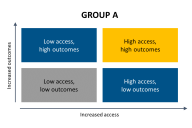You have /5 articles left.
Sign up for a free account or log in.

Adjunct- and instructor-level faculty are more likely to feel comfortable incorporating career development into courses.
monkeybusinessimages/iStock/Getty Images +
Faculty members serve as a critical resource for students charting their career paths, according to a new survey from the National Association for Colleges and Employers (NACE), with support from the American Association of Colleges and Universities and the National Society of Experiential Education.
The study—which included full professors on down to adjunct-level instructors—found 92 percent of faculty have been asked for career advice from a student in their disciplinary area within the past year, and three in five faculty have been solicited by alumni from their institution for career help.
The findings point to the role faculty members play in fulfilling student success goals as students launch into their lives after graduation, particularly because not every student engages with their career center. A fall 2023 Student Voice survey from Inside Higher Ed and College Pulse found one-third of all students had never interacted with their career center, a stat that remains similar (28 percent) among graduating seniors.
“Faculty are key stakeholders in the career journey,” said Shawn VanDerziel, chief executive officer of NACE. “The integration of what’s happening in a career center and their expertise is so important to translate to those faculty members as they are guiding students in their journey.”
Methodology
The survey was fielded during fall 2023 and included responses from 6,880 faculty members, ranking from full professor to adjunct professor from two- and four-year institutions across the country.
Faculty as Career Coaches
Four in 10 faculty members said they regularly advised 44 percent of their students in their disciplinary area on career exploration in the past year. In the fall 2023 Student Voice survey, seven in 10 students said at least one professor had helped them explore potential careers or develop specific career skills.
The new research found that faculty members at four-year institutions were more likely to have provided career advising (42 percent) to students than their two-year counterparts (38 percent), highlighting a larger trend of community college students not getting enough exposure to career preparation.
The most common advice students are seeking relates to career opportunities within their major (64 percent), graduate school decisions (56 percent) or internship opportunities (55 percent). Similarly, just over half of alumni have wanted a professor’s help with applying for graduate school (56 percent) or making professional connections (51 percent), faculty reported.
“Most students don’t exactly know what they’re going to do with their degree as they’re going through the program, and some wait too long to consider it,” VanDerziel said. “It’s incumbent upon us to help students think really broadly about how they can use their education to their advantage and to find their passion.”
Over half of faculty members say they’re “very comfortable” advising students inside their own discipline or major, but 22 percent say they’re not comfortable providing students with career advice.
Most faculty members rate their knowledge of careers within their disciplinary area (64 percent) as high or very high, and nearly half (47 percent) rate their knowledge of labor market information and trends as very high.
Just under four in 10 faculty want more information about the labor market and professional development in careers and career preparation to better advise students.
Careers in the Classroom
Integrating career readiness throughout the college experience has grown as an institutional priority to help students, parents and outside stakeholders see the value of higher education.
“Seventy-three percent of our schools are including some element of career readiness in classroom presentations, and many of them are collaborating with faculty to ensure it’s happening on an ongoing basis,” VanDerziel said, referencing NACE’s 2023 career services benchmark survey.
When asked how they partner with the career center, seven in 10 faculty said they refer students to the career center and two in five bring in career center staff to talk about career resources.
The primary challenge students face when transitioning from academia to the workforce is translating the work they’ve done in the classroom into real-world skills, VanDerziel has found. Most students complete group projects, which require analysis, effective communication, presentation and teamwork, but don’t articulate those learned abilities in interviews or on career materials.
“We need to be really direct with students about those experiences [and] how that translates to the world of work,” he said.
Faculty members can bridge this divide by talking about student work through the lens of career competencies. Eighty percent of faculty say they integrate career readiness and career information into their classes, the largest share aligning course assignments or course outcomes with career competencies.
Adjunct faculty (83 percent) and lecturers (84 percent) were most likely to say they integrate career information into their courses, which could point to these instructors’ own experiences working in the industry, as opposed to being career academics. To that point, 34 percent of faculty say they don’t include career information in their course because they don’t feel they have the background or expertise to do so.
While this study focuses on faculty and their role in a student’s career development, VanDerziel believes it is the entire campus’s responsibility to help refine learner’s career competencies and help them articulate their skills, whether that’s residence life, extracurriculars or on-campus employment.
He said, “Anywhere a student is building skills, it is really important for careers to be integrated."








